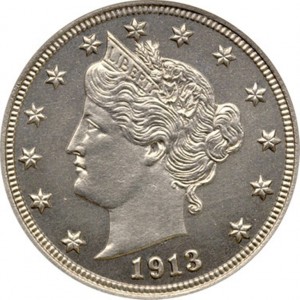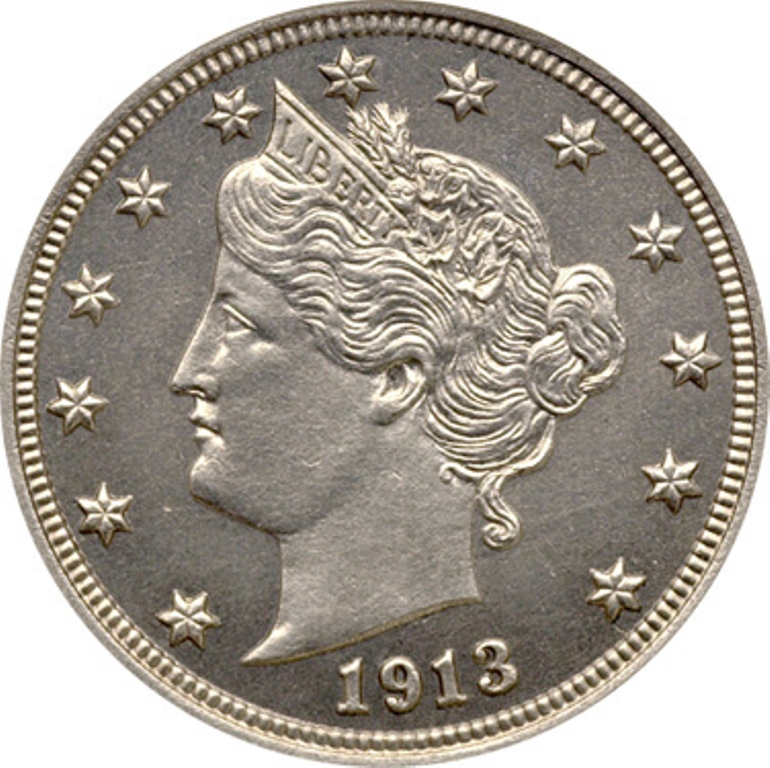 In April 2013, one of the only five 1913 Liberty Head nickels in existence was sold at auction and demanded a price of over 3 million dollars. Another one, which was sold in 2007, brought 5 million. The five rare coins are truly a treasure. But what makes these nickels so special is not only their rarity, but the story which surrounds them. It would seem the valuable coins were minted with a cunning thought of ‘if you want treasure, make one of your own’.
In April 2013, one of the only five 1913 Liberty Head nickels in existence was sold at auction and demanded a price of over 3 million dollars. Another one, which was sold in 2007, brought 5 million. The five rare coins are truly a treasure. But what makes these nickels so special is not only their rarity, but the story which surrounds them. It would seem the valuable coins were minted with a cunning thought of ‘if you want treasure, make one of your own’.
The exact circumstances for how and why only five Liberty Head nickels were produced at the Philadelphia mint in 1913 will probably never be known. It wasn’t even until the year 1919 that anyone (at least publicly) was aware of the possibility that 1913 Liberty Head nickels existed. The design for the 1913 nickel had changed in that year. It went from the Liberty Head, which had been minted from 1883 to 1912, to the design of the Indian Head nickels (minted from 1913 to 1938). There weren’t supposed to be any 1913 Liberty Head nickels minted.
Amazingly, though, five 1913 Liberty Heads were displayed at the American Numismatic Association Convention, seven years later. Evidently, before the change, five Liberty Head nickels were minted. The puzzling circumstance begins with Samuel W. Brown. In 1919, Brown placed an ad in the Numismatist magazine that offered to pay 500 dollars for a 1913 Liberty Head nickel (in proof condition, if possible). It was Brown who displayed the unique set of five coins at the ANA Convention in 1920.
Although it cannot be proven, it is speculated Brown already had, and knew he had (because he secretly minted them), the only five Liberty Heads existing in his possession when he placed the wanted ad in 1919. It is assumed the ad was placed by Brown to provide him with an explanation for how he had acquired the extremely rare coins for when he would later try to sell them for 600 hundred dollars. Since Brown was associated with the Philadelphia Mint in 1913, these suspicions are not unwarranted.
Brown was successful in selling the five coins after displaying them at the convention. The possession of the coins switched over to August Wagner. From Wagner, in 1924, the five coins moved to Ned Green’s Ownership. Upon Ned Green’s death in 1936 the coins would begin a separate journey. Eventually each coin was individually sold and each offer interesting tales of their own. If Brown is responsible for the minting of the coins, he did create a treasure, albeit illegally, for himself and others.
Today, two of the rare specimens have been acquired by museums. These coins are now commonly referred to as the Smithsonian and the ANA Liberty Head Nickels. The other three coins remain privately collected and change ownership on occasion. As can be expected when one of these coins are offered for sale, the coin collecting community is a buzz.
As mentioned, the latest one came up for auction in 2013. This Liberty Head was of particular interest because it was once thought to be lost. One of the nickel’s past owners, George Walton, was on way to a coin show where he promised to display his highly appealing coin. Tragically, on his way to the show, Walton died in a car crash. His coins were recovered from the scene, but when his heirs later tried to sell the 1913 coin, it was considered to be a fake. They had assumed Walton had kept the authentic coin stashed some place safe (and unknown to others) and was going to display a replica. Since the family could not find any other 1913 nickel in Walton’s belongings, the real one was assumed lost. For over 40 years, this was deemed accurate. However, later, in 2003, after another look, the coin was actually authentic. The treasure was right in front of them the whole time (isn’t that how it always is?).
Although the 1913 Liberty Heads bring high prices, they do not hold the record price paid for a rare coin. The current record is held by a 1933 Double Eagle. Being the only 1933 Double Eagle in existence to be legally owned, this eagle soared to a price of over 7 million! Read about its story in One of the World’s Rarest Coins.
For a person who is interested in history, collecting and learning about coins is a pleasure. A person never knows when they may come across the next treasure.

